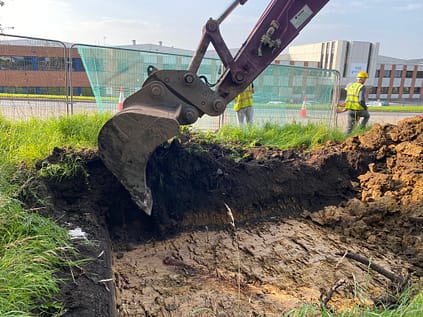The Environmental Impact of Construction
There have been numerous studies carried out over the past few years looking at the Environmental Impact of Construction.
These have attributed 50% of climate change, 40% of energy usage and drinking water pollution and up to 50% landfill waste as resulting from construction. The UK Green Building  Council has stated that more than 400 million tons of material is used by the construction industry per year.
Council has stated that more than 400 million tons of material is used by the construction industry per year.
In fact, building materials, such as steel and concrete, have been directly linked to large emissions of carbon dioxide due to their contents. It has also been stated that construction accounts for 25% of wood consumption globally.
With statistics like these, it is easy to see why construction has a large impact on the environment. As such, developers need to consider how to mitigate this impact whilst in the design phase of each project.
The Environmental Protection Agency requires that any construction project should consider the protection of the environment as a priority. This is supported by the Town and Country Planning (Environmental Impact Assessment) (England and Wales) Regulations 2011. These regulations require that an Environmental Impact Assessment is completed as part of the planning application for development projects.
An Environmental Impact Assessment is a report that considers the impact of any proposed development on the surrounding environment. This includes consideration of the cultural and human impacts as well as socio-economic. Developers can then use the Environmental Impact Assessment to tailor the project and mitigate any identified environmental impact.
Three possible ways that developers or construction sites could reduce their impact on the environment include:
Build Green
By using environmentally friendly materials throughout the construction phase, developers can reduce annual carbon dioxide emissions by up to 250 metric tons. Sustainable materials can be made up of recycled materials, be non-toxic or non-allergenic or be locally sourced, reducing the required transport time. Developers should also consider the energy and water efficiency of the building. This could be achieved by using specific energy saving facilities, the installation of solar panels and even the orientation of the building with the sun.
be made up of recycled materials, be non-toxic or non-allergenic or be locally sourced, reducing the required transport time. Developers should also consider the energy and water efficiency of the building. This could be achieved by using specific energy saving facilities, the installation of solar panels and even the orientation of the building with the sun.
Compensate For The Environmental Impact.
The requirements for biodiversity are about to change which will mean developers will be required to increase biodiversity by a minimum of 10% on any development projects. This can be achieved through the creation of new local habitats, including the planting of new hedgerows or the creation of a roof garden. This will help to mitigate the impact any construction has on the surrounding environment.
Consider Fuel Usage.
One of the easiest ways to reduce the impact of construction on the surrounding environment is to consider the use of fuel. Construction sites commonly involve a range of vehicles, whether that is for the construction work itself or for hauling materials to the site. By minimising travel distances, using alternative fuel sources or hybrid vehicles and reducing vehicle idling times, the production of emissions can be reduced significantly.
It is key, both for the protection of the environment and to abide by regulation, that developers start considering their construction methods and their impact on the environment.
ProHort Ltd provide a wide range of services that could help you to identify and mitigate any impact your project might have on the surrounding landscape. Check out our Services to see how we can help you.
